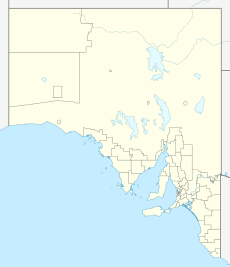world.wikisort.org - Australia
Blyth is a small town in the Mid North of South Australia, located 13 kilometres (8.1 mi) west of the renowned Clare Valley. The town is located on the lands of the Kaurna people,[2] the indigenous people who lived there before European settlement. It has a population of 306, the farming community spanning the plains between the Clare Hills and the Barunga/Hummocks ranges. Altitude is 189 metres (620 ft), and rainfall is approximately 400 millimetres (16 in) per annum.
| Blyth South Australia | |||||||||||||||
|---|---|---|---|---|---|---|---|---|---|---|---|---|---|---|---|
 Main street of Blyth, looking north | |||||||||||||||
 Blyth | |||||||||||||||
| Coordinates | 33°50′S 138°29′E | ||||||||||||||
| Population | 518 (2016 census)[1] | ||||||||||||||
| Established | 1875 | ||||||||||||||
| Location | 132 km (82 mi) north of Adelaide | ||||||||||||||
| |||||||||||||||
Located approximately 132 kilometres (82 mi) north of Adelaide, the district's climate and soils are well suited to wheat, barley, legumes, hay, sheep, cattle and pigs.
Blyth has a General Store, Post Office, Pub and Gallery/Studio, as well as sporting facilities for football, netball, bowls, cricket, tennis and golf. Several businesses based in Blyth service the region. The Blyth Cinema is housed in a renovated Masonic Hall.[3][4]
History
The township of Blyth was founded in 1875, 15 years after the Hundred of Blyth, in which it was located, was proclaimed.[5]
Railway
In 1876, Blyth was the terminus of the narrow gauge railway to Port Wakefield. This line ultimately was extended to Gladstone and converted to the broad gauge of 1,600 mm (63 in) in 1927 as the Gladstone railway line.[6]
Adjacent stations were Brinkworth to the north and Hoyleton and Halbury to the south.
See also
- Ian Roberts (painter)
- Stanley Football Association
- Jack Cockburn
- List of cities and towns in South Australia
- Lands administrative divisions of South Australia
References
- Australian Bureau of Statistics (25 October 2007). "Blyth (Urban Centre/Locality)". 2006 Census QuickStats. Retrieved 1 June 2008.
- "Kaurna People | Adelaidia". adelaidia.sa.gov.au. Retrieved 22 April 2016.
- Roberts, Ian (16 June 2008). "Blyth Regional Cinema: Winner, Westpac Australian Community Idol 2008" (PDF). Communities in Control Conference, 2008. Retrieved 31 July 2010.
- "Cinema". Blyth Progress Association. Archived from the original on 29 October 2012. Retrieved 31 July 2010.
- "Search for 'Hundred of Blyth, HD'". Property Location Browser. Government of South Australia. SA0007867. Retrieved 17 February 2016.
- Callaghan, W.H (2002). "Horse and Steam, Wheat and Copper". Australian Railway Historical Society Bulletin (January;February ed.): 9–27, 46–63.
Другой контент может иметь иную лицензию. Перед использованием материалов сайта WikiSort.org внимательно изучите правила лицензирования конкретных элементов наполнения сайта.
WikiSort.org - проект по пересортировке и дополнению контента Википедии